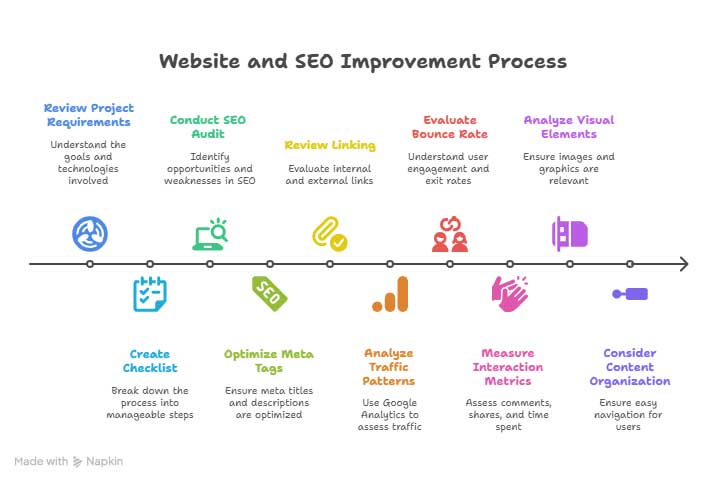A website audit is an essential process for any business or organization aiming to enhance its online presence and improve user experience. It is often referred to as technical SEO and, together with a good website design, can really help with online visibility and how Google rates your website. Not to be confused with SEO agencies offering a free audit just to get new business, a detailed website audit can really add value and improve returns. Here are some basic reasons why you should audit your website.
You can begin by reviewing your overall website and SEO project requirements and specifications in detail. Understand what it is you are trying to achieve and what technologies are involved. You can then break down the process into a checklist that when completed will improve your website. This should then occur on a regular basis (maybe monthly) and be part of a website maintenance program.
An SE) website audit helps identify opportunities or weaknesses in regards to search engine optimization (SEO) performance. A basic technical SEO audit should include keyword metrics, meta tags, and overall on-page content quality. You can optimize your site to improve its visibility in search engine results.
Check if meta titles and descriptions are optimized for search engines and relevant to the content.
Review the use of internal linking and external links to trustworthy sources.
Use Google Analytics to assess traffic patterns. Which pages have the highest and lowest engagement?
Evaluate the bounce rate to understand how quickly users leave the site after viewing a page.
Measure interaction metrics such as comments, shares, and time spent on pages.
Analyze the visual elements of the content. Are images, videos, and graphics relevant and high-quality?
Consider how the content is organized. Is it easy for users to navigate and find what they are looking for?

A More Detailed Website Audit Process
A free website audit would often just include the above data, but a more detailed process is needed for websites, that need that competitive edge or are operating in a more competitive arena. Your website performance could massively improve, by delving more deeply into a more comprehensive audit.
Let’s start with overall user experience (UX). Let’s be frank, UX is paramount in retaining visitors and converting them into money paying customers, lead genaration or brand awarness. A website audit assesses the overall design, navigation, and usability of your site, providing insights into how to create a more engaging and intuitive experience for users. Using the data from a UX audit should ultimately improve conversion rates.
Knowing your audience is crucial. Tailoring content to meet the interests, needs, and preferences of your target demographic can significantly increase engagement. Utilizing analytics tools can help identify what resonates most with your audience.
Who are the intended users? Consider demographics, interests, and needs.
Reviewing the content of a website, to make things simple, words and media. Is crucial for ensuring that it delivers both the needs of its target audience and the objectives of the business.
A thorough content audit can help identify opportunities, improve user engagement, and improve overall conversion.
Let’s look at some of the key components.
Analyze the use of keywords throughout the content. Are they effectively integrated without keyword stuffing?
Better content quality is essential for engaging audiences and building trust in an increasingly saturated digital landscape. High-quality content not only attracts readers but also encourages them to share and interact with the material, ultimately expanding its reach.
To achieve better content quality, several key factors should be considered:
The writing style should be clear, concise, and engaging and assist with on-page optimization.
Avoiding overly complex language can help ensure that the content is accessible to a broader audience unless it is specifically aimed at an educated minority niche.
Storytelling is a classic copywriting process that can also be employed to make the content more relatable and enjoyable.
Incorporating visuals such as images, infographics, and videos can enhance content quality. Visuals not only break up text but also help to illustrate points and make the content more memorable.
Understand the primary purpose of the website. Is it to inform, entertain, sell, or provide services?
Establish specific goals for the content. What do you want visitors to do? (e.g., sign up for a newsletter, make a purchase, or share information).
Assess whether the content is relevant to the audience and aligned with the website’s purpose.
While quality on-page seo content should always come first, optimizing for search engines can help ensure that it reaches its intended audience. This involves using relevant keywords, meta descriptions, and alt tags for images, as well as ensuring that the content is mobile-friendly.
Encouraging interaction through comments, social media shares, and calls to action can create a sense of community around the content.
Engaging with the audience helps build relationships and encourages repeat visits.
Use Important SEO Tools
Today’s SEO has moved on, and leveraging the right SEO tools is crucial for optimizing your website and improving its visibility in search engine results. Here are some essential tools that can help you enhance your SEO strategy:
This can start with Google Analytics which is a powerful tool that provides insights into your website traffic, user behaviour, and conversion rates. By using and understanding this data, you can make informed decisions about your content and marketing strategies. It will show what traffic to your website is delivered by what important pages and what may need improving elsewhere.
Probably the most important audit tool of all is the Google Search Console. This online tool helps you monitor your website’s presence in Google search results. The reason the data is important is that it is how Google sees and rates your website, not a third-party audit tool like some others. It is fair to say that not all information is provided by Google, but enough to make this still a valuable tool.
You can check the indexing status, optimize visibility, and identify issues that may affect your site’s performance. A critical section of the Google Search Console is the Core Web Vitals data. This can really help a webmaster delve into what is working on their website and what is not.
A comprehensive third-party SEO tool that offers keyword research, site audit, competitor analysis, and backlink tracking is Semrush. Used properly it helps you identify opportunities for growth and refine your SEO strategy.
Known for its claim to find more backlinks than any other audit tool, Ahrefs also provides keyword research, content analysis, and site audit features. It’s a valuable tool (and quite expensive to use) for understanding your competitors and especially for link-building opportunities.
Moz is seen as developing the Domain Authority or (DA) score, which we often see from backlink sellers. But it also offers a suite of SEO tools, including keyword research, site audits, and tracking of your rankings. It has a great website full of training and SEO Training information for those new to the subject.
If you’re using WordPress, the Yoast SEO is a plugin that can help optimize your content for search engines. It is important to also mention Rank Math, as it does something very similar. An excellent audit tool for removing duplicate pages and redirecting pages with a simple click. It can clean up the natural SEO flaws of a WordPress website.
Google Ads provides a tool that is designed for pay-per-click adverts. But this data can also be very valuable for natural SEO too. This tool helps you find keywords relevant to your business and understand their search volume and competition level. It’s essential for developing a targeted keyword strategy.
A user-friendly tool that offers keyword suggestions is Ubbersuggest. It can show content ideas and competitive analysis. Ubersuggest is particularly helpful for small businesses looking to improve their SEO and is cost-effective compared to some other audit tools.
A very popular website crawler that helps you identify SEO issues on your site, such as broken links, duplicate content, and missing meta tags is Frog. It can offer many suggestions on ways to improve your website. It’s an invaluable tool for conducting thorough site audits.
It has been a fact for some time now that page loading speeds are critical to ranking, especially in mobile results. A tool to measure these speeds is GTmetrix. It analyzes your site’s performance and provides actionable recommendations for improving loading times.m Page Speed Insights is another tool from Google so should not be ignored.
These tools can really assist a webmaster in delivering a good technical website audit and should be part of a typical SEO strategy, you can gain valuable insights, streamline your efforts, and ultimately boost your website’s visibility and performance in search engine results. You Are Trying To Improve SEO Performance
Mobile Responsiveness Is Critical
A mobile phone is now part of life and so the majority of web users access websites via their mobile devices. This modern shift has made mobile responsiveness not just a useful option, but a necessity for any website aiming to succeed. A mobile-responsive design ensures that your site adapts to various screen sizes from each phone or operating system. And then adapt is using a tablet or PC.
In terms of SEO rankings, search engines, particularly Google, like mobile-friendly websites in their rankings.
A better mobile experience can lead to higher conversion rates, so there is a business argument to it also.
All mobile users now expect fast-loading pages, even when using a sim card.
Compressing images down to size, reducing code where possible, and using plugins or browser caching code to improve webpage download times is a basic requirement.
Some more basic design features include Ensuring that buttons and links are large enough to be easily tapped on mobile devices. Avoid placing clickable elements too close together to prevent accidental clicks.
All this needs to be done as well as keeping content quality high.
A quality website audit will allow for all of the above to be included.
Competitive Analysis
Optimizing conversion rates is a crucial aspect of any online business strategy. It involves analyzing user behaviour, identifying obstacles in the conversion process, and implementing changes to increase the percentage of visitors who take a desired action, such as making a purchase, signing up for a newsletter, or filling out a contact form.
Here are some useful strategies to help your conversion rates.
As mentioned above, you need to understand your audience. Use tools like Google Analytics, and “heat maps”, to gain an understanding of what they like, their behaviours, and what they don’t like.
Call-to-actions should be clear, sometimes, with big buttons, persuasive, and strategically placed. Use a language that prompts users to press the button, such as “Let’s Go” “Sign Up Now,” or “Limited Time”.
Trust plays a significant role in conversion rates. Include customer testimonials, reviews, and trust badges on your website to reassure visitors of the quality of your products or services. Additionally, a clear return policy and secure payment options can further enhance consumer confidence.
Website Audit Checklist
Hopefully, by now, you will understand that running a website audit can significantly improve your website performance. There are different types of website audits, from the basic to that which is more technical. You can use your website audit checklist to improve your website content. Using the right site audit tool can give you the value data you need for conversions, rankings, download speed and customer satisfaction.
If you are after a complete website audit report, I would only review your website on a full audit basis, which is chargeable, on a monthly plan. I do not offer free audits which are only designed to obtain an SEO contract from you, rather than giving you the full picture.
